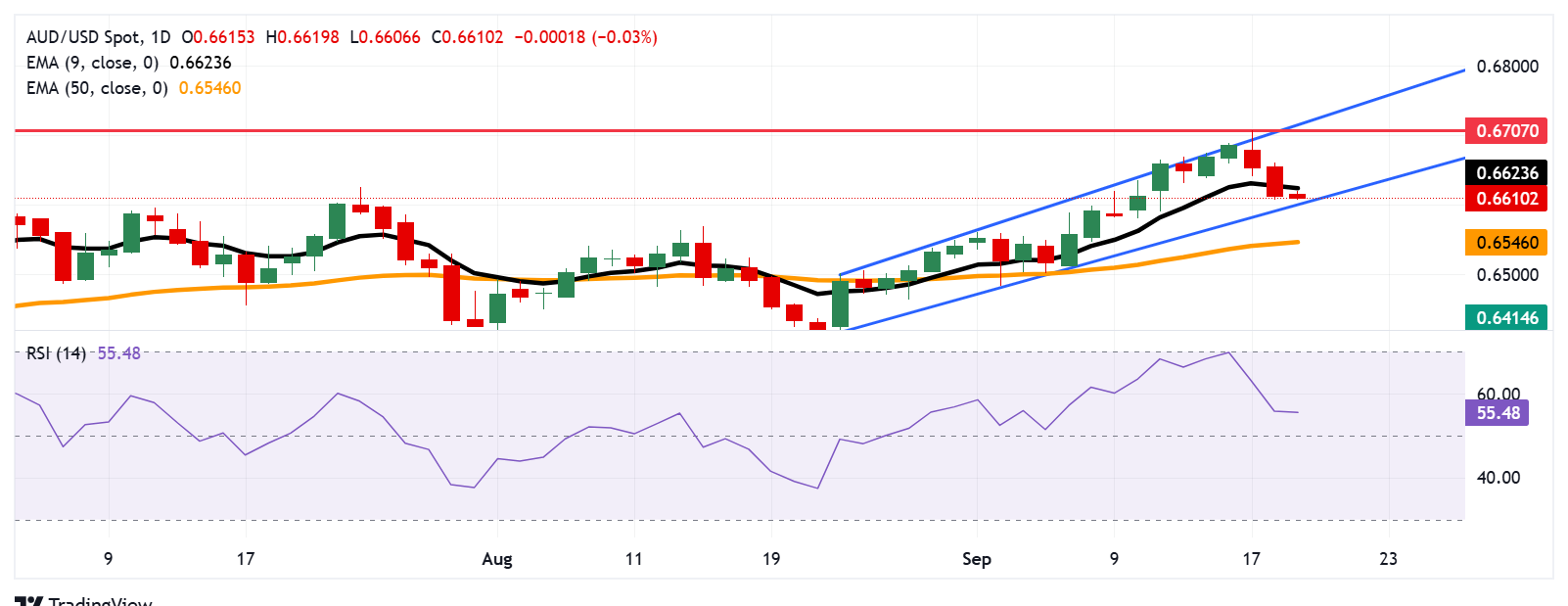Australian Dollar extends losses as US Dollar gains on steady Fed outlook
- Australian Dollar stays muted after softer-than-expected domestic jobs data for August.
- The AUD may regain its ground as markets now price just a 20% chance of a Fed rate cut in September.
- The US Dollar continues to gain after the release of Weekly Initial Jobless Claims.
The Australian Dollar (AUD) edges lower against the US Dollar (USD) on Friday, extending its losses for the third successive session. The AUD/USD pair remains subdued as the US Dollar gains support after the release of the United States (US) Weekly Initial Jobless Claims on Thursday.
The AUD also struggled after a weaker-than-expected jobs report, which showed that Australia’s seasonally adjusted Employment Change arrived at -5.4K in August from 26.5K in July (revised from 24.5K), compared with the consensus forecast of 22K. Meanwhile, the Unemployment Rate steadied at 4.2% in August, as expected.
The Aussie Dollar found support on the fading likelihood of further Reserve Bank of Australia (RBA) rate cuts. Markets now price just a 20% chance of a September cut, while odds for November stand at 70%, with above-target inflation keeping policymakers cautious.
US President Donald Trump said that he could further extend his trade truce with Chinese President Xi Jinping when the leaders speak on Friday, in addition to brokering a sale for TikTok’s US operations, Bloomberg reported late Thursday.
Australian Dollar gains as US Dollar advances after softer Initial Jobless Claims
- The US Dollar Index (DXY), which measures the value of the US Dollar against six major currencies, is gaining ground and trading around 97.40 at the time of writing.
- The US Department of Labour (DOL) released on Thursday, the Initial Jobless Claims went down to 231K for the week ending September 13. The latest print came in short of initial estimates of 240K and was lower than the previous week’s 264K (revised from 263K). Meanwhile, Continuing Jobless Claims are shrinking by 7K to 1.920M for the week ending September 6.
- The Federal Reserve (Fed) lowered the funds rate by 25 basis points (bps), marking the first cut of the year, and signaled a further 50 bps of easing before year-end, slightly above its June projections.
- Fed Chair Jerome Powell pointed to growing signs of weakness in the labor market to explain why officials decided it was time to cut rates after holding them steady since December amid concerns over tariff-driven inflation.
- The National Bureau of Statistics (NBS) showed on Monday that China’s Retail Sales rose 3.4% year-over-year (YoY) in August vs. 3.8% expected and 3.7% in July. Chinese Industrial Production increased 5.2% YoY in the same period, compared to the 5.8% forecast and 5.7% seen previously.
- The NBS said during its press conference on Monday that economic operation was generally steady in August, but domestic demand will expand and promote a rebound in prices. Some firms are having difficulties in operations as the external environment is very severe, NBS added.
- Reserve Bank of Australia (RBA) Assistant Governor Sarah Hunter said on Tuesday that the central bank is “close to getting inflation to target.” Hunter noted that risks to the outlook are balanced and emphasized the need for a forward-looking approach given the delayed impact of monetary policy. She added that the RBA is closely monitoring the underlying strength of consumer spending and aims to keep the economy near full employment.
Australian Dollar falls to near 0.6600 after breaking below nine-day EMA
The AUD/USD pair is trading around 0.6610 on Friday. Technical analysis on the daily chart indicates that the pair is remaining within an ascending channel, strengthening the bullish bias. However, short-term price momentum turned weaker, with the price moving below the nine-day Exponential Moving Average (EMA).
The AUD/USD pair may find its initial support at the ascending channel’s lower boundary around 0.6600. A break below the channel would weaken the bullish bias and lead the AUD/USD pair to test the 50-day EMA at 0.6546.
On the upside, the AUD/USD pair may target the nine-day EMA at 0.6623. A break above this level would improve the short-term price momentum and support the pair to approach the 11-month high of 0.6707, recorded on September 17, followed by the upper boundary of the ascending channel around 0.6720.
AUD/USD: Daily Chart

Australian Dollar FAQs
One of the most significant factors for the Australian Dollar (AUD) is the level of interest rates set by the Reserve Bank of Australia (RBA). Because Australia is a resource-rich country another key driver is the price of its biggest export, Iron Ore. The health of the Chinese economy, its largest trading partner, is a factor, as well as inflation in Australia, its growth rate and Trade Balance. Market sentiment – whether investors are taking on more risky assets (risk-on) or seeking safe-havens (risk-off) – is also a factor, with risk-on positive for AUD.
The Reserve Bank of Australia (RBA) influences the Australian Dollar (AUD) by setting the level of interest rates that Australian banks can lend to each other. This influences the level of interest rates in the economy as a whole. The main goal of the RBA is to maintain a stable inflation rate of 2-3% by adjusting interest rates up or down. Relatively high interest rates compared to other major central banks support the AUD, and the opposite for relatively low. The RBA can also use quantitative easing and tightening to influence credit conditions, with the former AUD-negative and the latter AUD-positive.
China is Australia’s largest trading partner so the health of the Chinese economy is a major influence on the value of the Australian Dollar (AUD). When the Chinese economy is doing well it purchases more raw materials, goods and services from Australia, lifting demand for the AUD, and pushing up its value. The opposite is the case when the Chinese economy is not growing as fast as expected. Positive or negative surprises in Chinese growth data, therefore, often have a direct impact on the Australian Dollar and its pairs.
Iron Ore is Australia’s largest export, accounting for $118 billion a year according to data from 2021, with China as its primary destination. The price of Iron Ore, therefore, can be a driver of the Australian Dollar. Generally, if the price of Iron Ore rises, AUD also goes up, as aggregate demand for the currency increases. The opposite is the case if the price of Iron Ore falls. Higher Iron Ore prices also tend to result in a greater likelihood of a positive Trade Balance for Australia, which is also positive of the AUD.
The Trade Balance, which is the difference between what a country earns from its exports versus what it pays for its imports, is another factor that can influence the value of the Australian Dollar. If Australia produces highly sought after exports, then its currency will gain in value purely from the surplus demand created from foreign buyers seeking to purchase its exports versus what it spends to purchase imports. Therefore, a positive net Trade Balance strengthens the AUD, with the opposite effect if the Trade Balance is negative.

